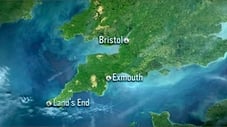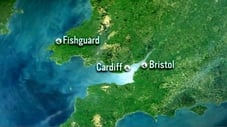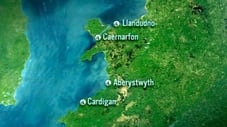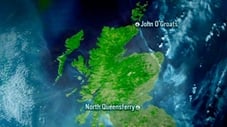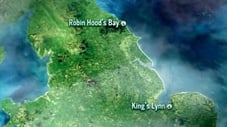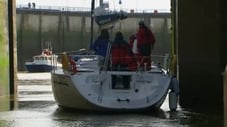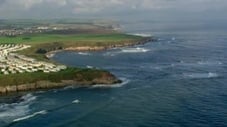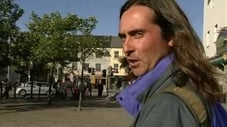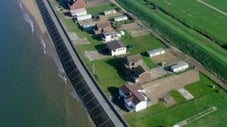
Coast (2005)
← Back to main
Alice Roberts as
Episodes 58
The Frontline: Dover To Exmouth
Traditionally the South coast of England is where we've fought our battles, and defended ourselves. A hop, skip and a jump away from the continent, divided only by the narrow stretch of the English Channel. It is Britain's front line.
Read MoreThe Wild West: Exmouth To Bristol
Dr Alice Roberts investigates how greed led to a village being washed into the sea; Nick unearths the history of slavery in Plymouth; while Neil and Mark try to wreck a ship with nothing but a candle; and Miranda comes face to face with a shark!
Read MoreTimes and Tides: Bristol To Cardigan Bay
South Wales has the second highest tidal range in the world. It is the tidal surge that creates the Severn Bore: Nick follows the wave upstream; whilst Neil explores the history of Cardiff coal; and Alice gets acquainted with the Red Lady of Paviland.
Read MoreThe Travellers Coast: Cardigan Bay To The Dee
Neil discovers the story of a Welsh Atlantis lost beneath the waves; Miranda goes in search of leatherback turtles; whilst Alice descends into the caves of Great Orme and Nick canoes in the treacherous Menai Straits, to examine the bridges across to Anglesey.
Read MoreShifting Sands: Liverpool To Solway Firth
Alice discovers 5,000 year old footprints on the beach; whilst Nick investigates our worst lifeboat disaster; Mark is on the track of the Roman conquest of Northern Europe in Maryport and Neil ventures onto the treacherous sands of Morecambe Bay.
Read MoreThe Troubled Coast: The Northern Ireland Coast
Nick investigates how the building of the Antrim Coast mirrors the troubled history of the province; Neil uses computer imagery to rebuild the Titanic; Alice heads to the Giants Causeway and Mark explores the wreck of a Spanish Armada treasure ship.
Read MoreIslands And Inlets: West Coast Of Scotland And Western Isles
Neil joins the crew of the trident submarine HMS Vanguard; Miranda goes hunting for Minke whales; whilst Mark and Neil recreate the inter island rocket mail service; and Nick sails the beautiful Western Isles armed only with a 500 year guide book.
Read MoreLife On The Edge: Cape Wrath To Orkney
Nick takes part in a NATO exercise at the Cape Wrath bombing range; Neil meets the descendants of the people displaced by the Highland Clearances; and the survivors of the worst loss of British Naval life in Scapa Flow; whilst Alice visits the Dounreay reactor.
Read MoreThe Working Coast: John O'Groats To Berwick
Miranda heads to the Moray Firth, home to bottle nosed dolphins; Nick investigates the impact of the North Sea oil industry; whilst Neil meets a fishing family in Fraserburgh, facing a bleak future; and Alice reflects on the history of whaling in Dundee.
Read MoreThe Forgotten Coast: Berwick To Whitby
Nick explores the holy island of Lindisfarne; Alice helps rebuild Britain's first house in Howick; whilst Neil examines the tensions in South Shields that led to race riots in the 1930s and Miranda gets up close and personal with grey seals.
Read MoreThe Inventive Coast: Robin Hood's Bay To The Wash
Nick retraces the steps of smugglers in Robin Hoods Bay; Neil goes to the first Butlins Holiday camp in Skegness; whilst Mark sets sail in a recreated bronze age boat; and Alice recreates alum crystals using stale urine!
Read MoreThe Vanishing Coast: The Wash To Dover
Nick investigates the freak floods of 1953; Alice explores the landbridge which joined us to the continent; whilst Nick meets Peter Boggis, a man trying to save his home from the sea; and Neil celebrates Trafalgar 200 examining an eye witness account of the battle.
Read MoreThe Future Coast
The final programme examines coastal issues highlighted in earlier episodes: sea level rise and erosion; the health of our seas and wildlife, power generation; and access to our coast; as well as development.
Read MoreCoast The Journey Continues: Dover to Carrick-a-Rede
Neil Oliver revisits some of the defining areas from the last two series. The first of the return journeys starts at Dover and heads along the South Coast of England, then sweeps around the dramatic peninsula of Cornwall. It then crosses the Irish Sea to Dublin for a bracing encounter with the coastline of Northern Ireland.
Read MoreCoast The Journey Continues: Southport to Dover
Neil Oliver revisits some of the defining areas from the last two series. This return journey starts in north-west England, heads north to Scotland and the Outer Hebrides, then leaps across to the Shetlands. It then returns down the east coast of Scotland and back into England concluding in the south-east, at Dover.
Read MoreCoast Revisited: West of Scotland - Dover
We don't have an overview translated in English. Help us expand our database by adding one.
Dover To Isle of Wight
The beautiful cliffs of Dover are a breathtaking sight. On this stretch of the coastline chalk has not only defined and shaped the landscape but has also been the starting point of many innovators and their pioneering work.
Our guide Neil Oliver takes over from Nicholas Crane this series, and guides us along this journey of beautiful scenery and remarkable discoveries.
Read MoreHolyhead To Liverpool
Neil Oliver explores an inaccessible cave inlaid with beautiful stonework - who was the mystery builder? Nick shows us how to read the history of your local beach and Alice traces the story of a foreign boy washed up on the Welsh shore and how he changed the history of medicine.
Read MoreArran To Gretna
Why did Alfred Nobel, founder of the famous prizes, pick the South West of Scotland as the ideal site for the world's biggest explosives factory? Nicholas Crane discovers the remarkable use for the island of Ailsa Craig's beautiful granite.
Read MoreCornwall & The Isles Of Scilly
Neil Oliver discovers the network of cables under a Porthcurno beach which wrap around the world in a tale of invention, espionage and surprise. Mark Horton visits the Isles of Scilly to meet the two football teams battling it out in Britain's smallest league and Alice Roberts paints up a storm in St Ives.
Read MoreDublin To Derry
Discover why Dublin is the greatest coastal city, join Mark Horton as he goes in search of the wreck of the SS Great Britain and Miranda Krestovnikoff spends a day at the races. Alice Roberts visits a remarkable house designed to see the sea from every room.
Read MoreNewcastle To Hull
The concrete and steel of the North East coast conceal a remarkable history of religious passion that transformed Britain and touched every corner of the world. Neil Oliver explores this ancient coastal landscape and also reveals its contribution to the abolition of the slave trade.
Read MoreThe Outer Hebrides
At the outermost edge of the British Isles, we discover the struggle to survive in this harsh but stunningly beautiful myriad of islands big and small. Crystal clear water and powder white beaches conceal a history of human tragedy and joy.
Read MoreFelixstowe To Margate
Alice Roberts savours the sea salt at Maldon, Miranda Krestovnikoff goes trawling on the Thames and we discover how the houses of Parliament can claim to be on the coast. We end the series with a remarkable cricket match miles out to sea on the eerie tidal landscape at Goodwin Sands.
Read MoreShetland To Orkney
Over 230 islands make up the Northern Isles - The Shetland and Orkney. These magnificent islands are made up of rock stacks, secret inlets and spectacular scenery, surrounded by sometimes extreme sea and weather conditions that have shaped these islands. Neil Oliver joins an expedition climbing the Old Man of Hoy in Orkney and finds out about the Second World War freedom fighters who risked their lives running the "Shetland Bus". Miranda Krestovnikoff goes in search of an elusive octopus, Nicholas Crane finds evidence of a tsunami that devastated Britain 7,000 years ago and Alice Roberts unearths a mysterious skeleton that reveals more about the lives of ancient Shetlanders.
Read MoreBournemouth To Plymouth
Neil explores why Sandbanks in Poole Harbour has some of the world's most expensive houses. Alice builds her own coastal 'property' as she investigates the perfect sandcastle. Dick joins an American serviceman on an emotional journey, as he returns to the beach where he was given up for dead during World War Two.
Read MoreSouthport To Whitehaven (Inc. The Isle Of Man)
Miranda is in search of the biggest sharks in British waters. Mark sees the Royal Navy's next generation of top secret 'Attack' nuclear submarines and Alice meets a woman who as a child was in the Isle of Man's internment camps, where 'enemy aliens' in Britain were held during the Second World War.
Read MoreCardiff To St David's
Neil discovers how a beach became the 'fastest place on earth' 80 years ago. Mark explores how Swansea's monopoly of the copper trade sped Nelson towards his Trafalgar victory. Miranda joins dolphins at the coast raising their young and Alice boards a dredger to discover how much sand we are consuming.
Read MoreBerwick-Upon-Tweed To Aberdeen
Miranda dives into a marine reserve off St Abbs, one of Britain's sites for underwater wildlife. Neil recreates a wartime scheme to train seagulls to search for German U-boats and Hermione explores the 400-year-old connection between a picturesque village and the birth of deep coal mining in Britain.
Read MoreGalway To Baltimore
Neil discovers how mysterious flotsam inspired Columbus' journey to America. Alice explores the botanical puzzle of "The Burren" - where Arctic plants grow next to Mediterranean flowers. Miranda reveals the surprising secrets of seaweed that make it the special ingredient in everything from toothpaste to beer.
Read MoreKing's Lynn To Felixstowe
Neil explores the site of an experimental Radar, built to spy on the Soviet Union. Alice tries to capture the beauty of Southwold in paint. Nicholas discovers how tides and weather can cause catastrophic floods and Hermione meets a woman who intercepted German radio messages from the Norfolk coast during World War 2.
Read MoreThe Channel Islands To Dover
Neil investigates the tragic story of the first channel swimmer. Alice explores Jersey's remarkable post war transformation from Nazi stronghold to 'Honeymoon Island'. Miranda enters secret caves and Mark reveals why the islanders on Guernsey remain loyal to the Queen, despite being outside the United Kingdom.
Read MoreShorts: Galloway Coast and Solway Firth
The Coast team visits the vast, windswept mudflats of the Solway Firth. They are a haven for barnacle geese but heartbreaking for local coastguards who must rescue illegal cockle pickers.
Read MoreShorts: Lobsters
Miranda Krestovnikoff discovers how lobster stocks are being sustained by the local fishing industry in Padstow, Cornwall.
Read MoreShorts: Saltburn to Scarborough
The team journey to Saltburn, a resort founded by the Victorian entrepreneur Henry Pease. His vision was to create a 'heavenly city above the cliffs'.
Read MoreShorts: Copper
Mark Horton explores how Swansea's monopoly of the world copper trade helped Nelson towards his victory at the Battle of Trafalgar. Neil Oliver travels to Langland Bay to meet Betty Philips and makes lavabread out of lavaweed, a Welsh delicacy. Neil also meets Rowland Pritchard, the owner of Gower Salt Marsh Lamb co-operative.
Read MoreWhitstable to Isle of Wight
The south coast of England was the home of movies long before a frame was shot in Hollywood, thanks to long hours of daylight and glamorous London actors holidaying by the sea. Neil Oliver tries his hand at directing his own silent movie. Alice Roberts re-lives the glamour days of the hovercraft and on the Isle of Wight, we go in search of dinosaur footprints which prove the island has been on an epic voyage heading north from tropical climes 135 million years ago.
Read MoreCap Gris-Nez to Mont Saint-Michel
Castles are an integral part of the history and landscape of Britain, but the art of building a castle was brought across the channel by William the Conqueror. We visit the medieval quarry in France which supplied the stone for iconic buildings such as the Tower of London and Canterbury Cathedral. Nick Crane sets sail from Dover to visit the white cliffs of France. Connected by land before a mega flood carved the channel, Nick discovers that these divided cliffs are facing parallel challenges of coastal erosion.
Read MoreLands End to Porthcawl
3,500 years ago, an international demand for Cornish tin put Cornwall at the centre of an internation arms trade. Mixed with copper, Cornish tin made high quality weapons, giving birth to the British Bronze Age. Hermione Cockburn discovers what happened when American media mogul and inspiration for Citizen Kane William Randolph Hearst, made a run-down castle with a sea view into a little hideaway for him and his mistress on the Welsh coast. Neil Oliver visits Porthcawl to trace the history of the Welsh Great Escape.
Read MoreCork to Dublin
We visit Cork Harbour, Titanic's last port of call before sailing to disaster, to hear the story of one lucky Irish passenger who had to reluctantly disembark at Cork. Alice Roberts meets Waterford Crystal's chief scientist to learn how to turn the local beach's sand into glass. Hermione Cockburn creates her own mini earthquake on Killiney beach with a mercury dish and some dynamite, recreating an experiment performed 160 years ago that led to the understanding of the earth's tectonic plates.
Read MoreAnglesey to Blackpool
Blackpool is Britain's most visited seaside destination. How has the resort succeeded when others have gone under? The pleasure park is one of many innovative attractions imported here from America. Neil Oliver views the coast at high speed with a visit to the RAF's world famous "Pilot Factory". As he takes to the skies in a Hawk Jet with an instructor, can he travel from Anglesey to Blackpool and back in just under half an hour?
Read MoreInner Hebrides to Faroe Islands
The Sea Eagles of the island of Canna were hunted to extinction, but now they have been brought back. We climb into one of their nests perched high on a steep cliff to find out what their chances of survival are. Neil Oliver visits Europe's biggest super-quarry to receive an explosive lesson in how the rock is mined. Armed with a simple ruler on a Scottish beach, Nick Crane learns how the challenge of measuring our coastline led to a new branch of maths that could help our mobile phones get smaller.
Read MoreNorway: Lillesand To Svalbard
In Coast's Norwegian odyssey we explore how the Ice Age is still affecting Norwegians today; a collapsing mountainside threatens to thunder down into one of the country's most beautiful fjord's creating a devastating tsunami. Nick Crane visits the little town of Geiranger which sits in the path of the impending tidal wave.
Read MoreRosyth to Hull
On Holy Island, we find out how a Viking attach inadvertently united the Anglo-Saxon kingdoms, creating a new national identity as they came together to resist a new enemy. Mark Horton navigates to Marine Esplanade in Ravenscar in search of the "town that never was". Destined to be a buzzing Victorian seaside parade, Mark uncovers why it is now just an empty field. Following three unsuccessful attempts to land a boat on Bass Rock, Miranda Krestovnikoff beats Neil Oliver to the challenge and is rewarded with a front row view of the diving gannets.
Read MoreShorts: Marine Reserve
Miranda Krestovnikoff dives into a spectacular marine reserve off St Abbs, one of Britain's outstanding sites for underwater wildlife. Neil Oliver travels up to North Berwick to visit the Bass Rock, once upon a time the site of one of Scotland's most notorious prisons.
Read MoreShorts: Northern Islands
Neil Oliver discovers the remarkable story of the World War II freedom fighters who risked everything running the Shetland Bus, a series of top secret missions into Nazi-occupied Norway. One of the worst environmental disasters hit the coast at Garths Ness in 1993: Braer, an oil tanker, ran aground and spilt 84,000 tonnes of toxic crude oil into the sea, polluting Shetland's coastline and wildlife. Neil takes a ride on the world's shortest scheduled flight, between Westray and Papa Westray, which provides an important link to these small communities. Mark Horton explores dangerous waters when he joins one of the world's most sophisticated survey ships on a mission to find the uncharted hazards that wreck unwary vessels in Orkney.
Read MoreHeart Of The British Isles - A Grand Tour
In this first episode the team embark on an extraordinary circular tour of the Irish Sea to visit every country and territory within the United Kingdom. The hub for this wheel around the heart of the British Isles is the Isle of Man where Neil Oliver explores the small island. On the edge of the Irish Sea at Morecambe Bay, Alice Roberts gets trapped in quicksand to discover why it is so sticky and so deadly. In Northern Ireland, Miranda Krestovnikoff sees how seals cope with the struggle to find food as they bring up pups in the beautiful inland sea of Strangford Lough. Nick Crane goes sea cliff climbing on the remarkable rocks of Anglesey as he explores why this corner of North Wales is the site of some of Britain's biggest earthquakes.
Read MoreSwanage to Land's End
Neil Oliver performs the lead role in an extract from Shakespeare’s "The Tempest" on the stage of a remarkable coastal amphitheatre near Land's End. Nick Crane ventures out into the infamous "Portland Tidal Race" to see how this fearsome tidal surge creates some of the roughest waters in Britain, surprisingly close to the tourist beaches and Georgian splendour of Weymouth. Miranda Krestovnikoff goes in search of a family of White-Beaked Dolphins and Alice Roberts follows her nose to discover what gives the sea its distinctive smell. In Devonport, Mark Horton has privileged access to the historic dockyards to see where the wooden ships of Nelson’s Navy were built. Mark reveals how the steel fleet of the modern Royal Navy still relies on the age old skills of wood working.
Read MoreBrittany
Neil Oliver explores the province of Finistère, "The End of the Earth", and meets a lighthouse keeper made famous by one of the world's most reproduced photographs. Nick Crane joins the "Onion Johnnies", who gave us our stereotypical image of a Frenchman, complete with stripy tee shirt, beret and bicycle laden with onions. Alice Roberts reveals the life saving chemical element that's locked away inside seaweed and Miranda Krestovnikoff dives for a seafood delicacy. At Carnac, Mark Horton wanders amongst the mysterious lines of standing stones, erected thousands of years before Stonehenge, to investigate their age old connection with Britain.
Read MoreGower to Anglesey
Neil Oliver takes part in an aerial dogfight to discover why a Nazi flying ace landed his top secret new plane on Welsh tarmac at the height of the Second World War. Miranda Krestovnikoff visits a seabird paradise, the magical island of Skomer, and at Porth Oer, Alice Roberts attempts to solve the riddle of the "Singing Sands". What makes some very special British beaches whistle when you walk on them? Mark Horton visits and imposing castle at Harlech, one of the best preserved in Britain. Nick Crane explores the violent history of smuggling around the gorgeous Gower Peninsula and abseils into an extraordinary stone structure concealed in the side of a sea cliff.
Read MoreGalway to Arranmore Island
Just five months before President John F. Kennedy was assassinated in Dallas, he was riding in an open top limo through the crowded streets of Galway. Neil Oliver meets the photographer who managed to get up close and personal with the President and talk him into the perfect snap. Miranda Krestovnikoff explores an odd little island where the mountain hare population is thriving and Nick Crane investigates a local legend that says that Clew Bay has 365 islands, one for each day of the year. Alice Roberts unearths the remarkable remains of the oldest farm in the British Isles.
Read MoreGlasgow to Edinburgh via Caledonian Canal
Neil Oliver joins the crew of the last surviving coal fired, steam-powered, "Clyde Puffer". Amateur artist Alice Roberts explores what drew Joan Eardley to Catterline and how her life was cut tragically short on the verge of great success. Nick Crane reveals how the majestic Loch Ness became part of Britain's biggest building project in the early 1900s. Miranda Krestovnikoff dives into Loch Creran to explore how the tiny worms built a giant reef known as Worm City. Hermione Cockburn visits the "Islands that Roofed the World" and Mark Horton unearths what remains of the mysterious and violent people who once ruled much of Scotland, the Picts.
Read MoreDenmark
The Danes top the polls as the happiest people on earth and Neil Oliver wants to know what they have to smile about. Nick Crane investigates how the Danish made a big business out of selling bacon to Britain. Alice Roberts sets sail in a full scale replica of a Viking longship to see how these ships gave Norsemen the advantage over the English in battle. Miranda Krestovnikoff meets some unflappable red deer. On Heligoland, Mark Horton reveals how in 1947 Britain's Royal Navy blew this tiny island apart in the largest non-nuclear explosion the world had ever seen and Dick Strawbridge gets access to the construction of one of the world's largest offshore wind farms.
Read MoreShorts: Old Head of Kinsale to Ardmore
Coast breaks new ground with a spectacular journey following the southern shoreline of Ireland, from the Old Head of Kinsale to Ardmore.
Read MoreHull to London
Neil Oliver visits the birth place of his seafaring hero Lord Nelson. On the eerie shingle bank of Orford Ness, Alice Roberts leads a team trying to recreate the original war-winning experiment which proved that Radar would work. Off the Norfolk coast, Nick Crane explored the remarkable lost world of "Doggerland". Miranda Krestovnikoff wades out into the mud of the Wash", a vast tidal feeding ground for migrating birds. To investigate the appeal of the glorious Essex Fishing Smacks, Mark Horton joins a crew on competition around the Thames Estuary.
Read MoreShorts: Norman Construction
Mark Horton discovers how William the Conqueror taught the English the art of constructing castles, and why William looked to Normandy for the stone to build the Tower of London.
Read MoreShorts: Rottingdean and Volks Electric Railway
A look around the coast of the British Isles. Mark Horton visits Rottingdean to peek over Rudyard Kipling's garden wall and follow in the footsteps of the Victorian celebrity hunters, before unearthing the history of a unique Victorian electric railway which ran underwater - Magnus Volks' bizarre and beautiful 'Daddy Long-legs'.
Read MoreShorts: Dover to Selsey Bill
Kate Rew, an outdoor swimmer, explains why swimming along the coast is the perfect antidote to the stress of modern life. Neil Oliver explains how the Kent marshes were formed and how local frogs were thought to have been brought over from France in the 1930s, but are in truth Hungarian Marsh frogs. Miranda Krestovnikoff discovers how the Hastings fishermen cope without a harbour by launching their boats off the beach.
Read MoreShorts: Faroe Islands
Coast heads high into the wild Atlantic to the majestic Faroe Islands, where Neil Oliver discovers how romance blossomed for British soldiers and Faroese women during the Second World War's 'Operation Valentine'.
Read MoreShorts: Trondheim, Svalbard and the Lofoten Islands
The Coast team continue to explore coastlines around the world.
Read MoreShorts: Norwegian Energy
Alice Roberts visits a processing plant that supplies one-fifth of Britain's gas requirements via the world's longest sub-sea pipeline. In 40 years the gas will all be gone, but Alice discovers a potential new form of renewable energy - osmotic power.
Read MoreShorts: Ravenscar to Hull
Mark Horton travels to Ravenscar to investigate the resort that never was, and Neil Oliver is in Hull to retrace the footsteps of 19th-century immigrants who passed through the port on their way to a new life in the New World.
Read MoreShorts: Rosyth to Sunderand
The team are travelling down the UK's North East coast. Miranda Krestovnikoff finally manages to get out to Bass Rock, Neil Oliver investigates a legend in Cullercoats and Dick Strawbridge has a riveting experience in Sunderland.
Read MoreShorts: Brighton's Early Cinema
Neil Oliver becomes a silent movie director as he films a scene from The Mayor of Casterbridge using an antique camera, to reveal how pioneers in Brighton taught the world to make movies long before Hollywood shot a frame.
Read MoreShorts: Glensanda
Neil Oliver travels to the majestic Faroe Islands to discover how romance blossomed for British soldiers and Faroese women during the Second World War's 'Operation Valentine'. Neil begins his island hopping journey at Glensanda, the site of Europe's biggest super-quarry, which provides the rock to make the roads of Britain roll. He also searches for sea eagles, recently reintroduced to the island of Canna.
Read MoreShorts: The Needles: Isle of Wight
Nicholas Crane crosses the Solent to find out what's happened to England's largest island - the Isle of Wight.
Read MoreShorts: North Devon and Somerset Coasts
Documentary series. Thanks to the toil of Welsh miners, who dug tunnels through solid rock to open up the beaches of Ilfracombe, wild swimmer Kate Rew is able to introduce a reluctant Neil Oliver to some of the more surprising joys of sea bathing Victorian style. On Exmoor's treacherous sea cliffs, Nick Crane is challenged to a sideways climb that was inspired by the conquest of Everest. He meets the men who set a record for this uniquely British endurance test, and finds out why, decades on, that feat has yet to be equalled. And we see how a mud horse fisherman collects his catch.
Read MoreShorts: Whitstable to Isle of Wight
In Dover, Alice Roberts re-lives the glamour days of the hovercraft crossing to France.
Read MoreShorts: Waterford to Hook Head
In Waterford, Alice Roberts learns how to make glass from sand. Neil Oliver also engages with an ancient skill, the extraction of entire millstones from Herrylock beach using the power of the sea. He later visits the oldest intact operational lighthouse in the world at Hook Head.
Read MoreShorts: RAF Valley
We don't have an overview translated in English. Help us expand our database by adding one.
Shorts: Holy Island
Mark Horton is on the Holy Island of Lindisfarne, reliving the first Viking raid on our shores in June 793 AD. He discovers how those marauding Norsemen galvanised the warring Anglo-Saxon kingdoms to come together and form the English nation.
Read MoreLondon to Antwerp
The latest adventure begins in the historic heart of London, continues along the south coast of England and out across the channel to explore the curious coast of Belgium. Nick Crane discovers why the world's biggest cargo ships are on course for London before crossing the channel to Belgium; he rides one of the longest tramways in the world, and investigates how a beautiful seaside resort became the base for Albert Einstein's battle against Nazi tyranny. Neil Oliver reveals the remarkable tale of Hitler's audacious gamble in 1942, when his biggest battleships steamed straight along the English Channel in broad daylight. Alice Roberts uncovers the surprising story behind the rise and fall of the seaside landlady. In the fabulously preserved medieval city of Bruges Mark Horton unearths why our ancestors came there 700 years ago to re-discover the forgotten art of making bricks. Plus, Miranda Krestovnikoff is on the Belgian coast to meet the last few men who still use heavy horses to fish for shrimp.
Read MoreThe Netherlands
The team's journey continues around the stunning shores of Devon and Cornwall. Nick Crane is on a fishing expedition on board one of the last remaining Brixham trawlers. He also explores how Henry VIII, fearing attack after his famous divorce, built a string of cleverly positioned forts all along the south coast. The Isles of Scilly are surrounded by lush, golden green underwater meadows of seagrass; Miranda Krestovnikoff explores the diverse wildlife of this natural sub-sea paradise. Mark Horton reveals the extraordinary story of how Lawrence of Arabia went to Plymouth, where he helped develop revolutionary fast rescue boats that saved countless lives in the Second World War. Dick Strawbridge learns the surprising secrets of the global steam power revolution pioneered in the tin mines of Cornwall some 200 years ago. And with the aid of some big wind machines, Alice Roberts creates her own perfect storm.
Read MoreDevon and Cornwall
Coast ventures out to brand new territory, the astonishing man-made shoreline of the Netherlands. Nick Crane explores how ingenious Dutch engineers created massive coastal defences like no others on earth following the great North Sea flood in 1953 which killed thousands of people in the Netherlands and Britain. Nick also discovers how, during the Second World War, traitors from the British Indian Army took part in the Nazi occupation of the tiny isle of Texel - the unlikely site for the last battle in Europe of the Second World War. Coast newcomer, historian Tessa Dunlop, is on the trail of Tulipmania, the extraordinary trade in tulip bulbs that's said to have nearly bankrupted the Dutch nation nearly 400 years ago. Mark Horton reveals the age old skills that have made the Dutch the Grand Masters at creating new living space from the sea. Adam Henson, himself a farmer, investigates why cows from the coastal plains of the northern Netherlands became the most sought after milk producers in the world, and one of the most familiar sights in the British countryside. Miranda Krestovnikoff experiences how the Dutch delight in devouring raw herring as a sea side snack!
Read MoreWestern Isles and Shetland
Coast embarks on an island-hopping adventure in Scotland around the stunning Western Isles and out to the northern outpost of Shetland. On Eriskay, Nick has a close encounter with a family of dolphins and he is invited to a golden wedding anniversary where the whole island gather to party. On the Isle of Lewis, Nick meets the leader of the Guga Hunters, a small band of men following the age-old tradition of catching young gannets. Neil Oliver explores the tragic shipwreck of the Iolaire. On New Year's Eve 1918, over 200 servicemen returning home from the First World War, drowned within sight of their homes on the Isle of Lewis as the Iolaire was torn apart in ferocious seas. Hermione Cockburn is on an expedition to Staffa. Armed with an acoustics expert, a violinist, and a starting pistol, she conducts a curious experiment to explore the remarkable musical quality of Fingal's Cave. Miranda Krestovnikoff is on Shetland to search for the shy otters who struggle to survive on this wild coast. Tessa Dunlop is on a deep-sea survey ship to see how the epic voyage of HMS Challenger first revealed the astonishing secrets of life in the depths of the world's oceans.
Read MoreWales Border to Border
Coast travels right around the wonderful Welsh coast from the Severn estuary, to the Dee estuary. Nick Crane investigates the evidence that a devastating tsunami crashed on to the coast of Wales and England some 400 years ago. Villages were wiped off the map and thousands died, leaving the survivors to believe they had suffered the judgement of God; but was it a tidal wave that was to blame? Nick also discovers why scientists planning an expedition to the Red Planet find the Welsh coast a surprisingly good stand-in for the surface of Mars. Alice Roberts attempts to get airborne with just helium balloons attached to her waist as she tests the claim that the world's first powered flight was actually made by a Welsh carpenter. Meanwhile, Miranda Krestovnikoff lands where few people ever tread - on Grassholm; an extraordinary island normally kept exclusively for the birds. In 1947 two brothers were on holiday on Anglesey when one sketched a rough notion in the sand for a completely new kind of vehicle - Dick Strawbridge explores how that coastal blueprint became the plan for the Land Rover. Plus Tessa Dunlop reveals how some 30 years ago an army of local volunteers managed to keep 3,000 Asians, who had been expelled from Uganda, warm and well-fed in an abandoned military base during a Welsh seaside winter.
Read MoreSweden and the Baltic
For centuries Britons have charted a course to the glorious coast of Sweden for its treasure trove of riches, now for the first time Coast explores the British connections to this stunning shore on the edge of the Baltic Sea. Nick Crane's journey starts in one of the most picturesque parts of Sweden, the dramatic peaks of the High Coast are a wonder of the world and, remarkably, the mountains are still growing at the rate of one centimetre every year. Nick also finds out why Britain's early engineers had to come to Sweden for iron to help forge our Industrial Revolution. Alice Roberts explores the extraordinary story of how, during the Second World War, Britain's military effort almost ground to a halt without Swedish ball bearings and how brave British servicemen beat the German blockade of the country. Mark Horton visits the world's most remarkable shipwreck, The Vasa, which has been called the Tutankhamun of maritime archaeology. Dick Strawbridge climbs the rigging of one of the last great commercial sailing ships, known as the Windjammers. As recently as the 1940s these tall ships managed to give steamships a run for their money. Dick discovers how in the days of Empire, the Windjammers connected Britain to Australia with their legendary grain races. The team also explore Abba Island and search out moose in Sweden's frozen North.
Read MoreShorts: Lowestoft Pier
Mark Horton visits Claremont Pier in Lowestoft and investigates the current perilous state of our seaside piers.
Read MoreShorts: Anglesey Geology
Nick Crane goes sea cliff climbing on the remarkable rocks of Anglesey as he explores why this part of Wales is the site of some of Britain's biggest earthquakes.
Read MoreShorts: Falmouth to Land's End
Neil Oliver explores the lasting legacy of black American GIs who came to Britain to prepare for D-Day. Neil also performs the lead role in an extract from Shakespeare's The Tempest on the stage of a remarkable coastal amphitheatre near Land's End. He discovers how this unique theatre was built thanks to the obsession of one woman determined to stage the Bard's famous play in the open air next to the sea at her home in Cornwall.
Read MoreShorts: Whitstable to Red Sands Sea Fort
Beginning at the famous Oyster Festival in Whitstable, Neil Oliver ventures offshore to the remarkable Red Sands Sea Forts. Built as air defences in the Second World War they went on to inspire the design of the first North Sea oil rigs.
Read MoreShorts: Swanage to Land's End
A journey along the sights of England's South West coast from Dorset, through Devon, and onwards to the tip of Cornwall. Neil Oliver finds out how the arrival of steam trains transformed the South Coast by opening it up to tourists. He also performs the lead role in an extract from Shakespeare's 'The Tempest' on the stage of a remarkable open air amphitheatre near Land's End, discovering how this unique theatre was built thanks to the obsession of one woman determined to stage the Bard's famous play next to the sea at her Cornish home. Miranda Krestovnikoff goes in search of a family of White-Beaked Dolphins. These elusive cold water creatures are rarely seen off the English Coast, so why is this group so far south? Nearby, on a rocky South Coast beach, Adrian Gray demonstrates the gravity-defying art of balancing stones.
Read MoreShorts: Onion Johnnies
Nick Crane joins the Onion Johnnies. For nearly 200 years the Onion Johnnies have pedalled their produce around Britain, giving us our stereotypical image of a Frenchman, complete with stripy t-shirt, beret and bicycle laden with onions. Nick finds out what's so special about their onions and meets one of the Johnnies who married a Geordie girl.
Read MoreShorts: Dorset
A look around the coast of the British Isles. Nick Crane ventures out into the infamous Portland tidal race to see how this fearsome tidal surge creates some of the roughest waters in Britain surprisingly close to the tourist beaches and Georgian splendour of Weymouth.
Read MoreShorts: Harlech and Criccieth
The imposing castle at Harlech is one of the best preserved in Britain but Mark Horton discovers how it would have looked radically different and even more terrifying when it was built to subdue the Welsh in the 13th century. Across the bay, Neil Oliver is at the Welsh's rival castle at Criccieth.
Read MoreShorts: Anglesey
On this Coast journey from Anglesey to Blackpool, Neil is joined by some familiar faces. Nick Crane is seeking out the story of a tiny harbour that played a big part in making a mountain of money at Parys Mountain, and Almwich Port which served it. Hermione Cockburn discovers how postcards from the past reveal a vital message for the future of our seaside in Rhyl, and the history of the Pleasure Beach at Blackpool. Miranda Krestovnikoff is on a sand dune safari in search of creatures great and small. Mark Horton is hunting for the remains of what was once the world's biggest private dock at the site of an early soap manufacture at Port Sunlight. Neil takes a journey of a different kind to the coast about a RAF jet. He also explores a shipwreck that is disappearing before his eyes and sees if he can trace Alice and her wonderland in Llandudno.
Read MoreShorts: Gower to Pembrey
Nick Crane explores the violent history of smuggling around the gorgeous Gower Peninsula, and abseils into an extraordinary stone structure concealed in the side of a sea cliff. Now only accessible by sea or by ropes, 200 years ago this was the perfect smugglers' stronghold, but Nick learns that it had an even more mysterious previous life - as a massive medieval bird house.
Read MoreShorts: Croagh Patrick to Beal Derrig
Exploring Britain's coastline. Coast ventures to brand new territory, the storm battered Atlantic shore of Irelands majestic northwest coast. Local legend says that Clew Bay has 365 islands one for each day of the year; Nick Crane investigates how this astonishingly beautiful and unusual landscape was created when Ireland was covered in ice. Neil Oliver discovers how the infamous 16th century Pirate Queen Grace OMalley turned her coastal home into an impregnable fortress. And Alice Roberts unearths the remarkable remains of the oldest farm in the British Isles, a complex system of walls and houses laid out before Stonehenge; the ancient ruins of these Stone Age farmers have been buried in the peat for over 5000 years.
Read MoreShorts: Galway to Clifden
Coast ventures to the storm battered Atlantic shore of Ireland's majestic north west coast. Neil Oliver visits an Atlantic sea monitoring station off the coast of Galway. Further up the coast at Clifden, Dick Strawbridge leads a team of radio experts trying to recreate 100-year-old technology developed by Marconi, who sent the first commercial wireless messages across the Atlantic using steam generators powered by peat and an antenna over half a mile long.
Read MoreShorts: Gower to Anglesey
Neil Oliver ventures out onto Worm's Head, a snake of land reaching out of the Gower Peninsula. Further up the coast he finds out about the quarrying heritage of Abereiddi and Porthgain. At Porth Oer Alice Roberts attempts to solve the riddle of the 'Singing Sands': what makes some very special British beaches whistle when you walk on them? Alice records the sounds of Porth Oer's beautiful beach to reveal its surprisingly musical secrets.
Read MoreShorts: JFK in Galway
Just five months before president John F Kennedy was assassinated in Dallas he was riding in an open top limo through the crowded streets of Galway. Neil Oliver meets a photographer who covered JFK's motorcade on one of his first assignments and hears how this junior pressman managed to get up close and personal with the president and talk him into the perfect snap.
Read MoreThe Mysteries of the Isles
Coast is back in the UK and, for the first time, each episode will feature stories from every part of the British Isles, taking viewers on a 'journey of the imagination' which explores the universal themes that bind everyone together.
Nick Crane signs on as a deck-hand with a tall ship, reliving the great days of sail on a gruelling yet exhilarating journey between the Northern Isles of Scotland. Nick hopes to fulfil a childhood ambition by setting foot on tiny 'Fair Isle'. This is the most remote populated outpost in the British Isles and home to just 70 hardy souls. Can Nick uncover the mystery of how this tiny community's struggle to survive was successful, when many other larger Scottish islands were abandoned?
At Scapa Flow on Orkney, Neil Oliver explores the conspiracy theories surrounding the mysterious death of Lord Kitchener. Kitchener was one of over 600 soldiers and sailors who perished when their ship went down. Neil meets locals on Orkney who believe tales of suspicious events on the fateful night of the wreck.
Historian Tessa Dunlop hopes to witness an extraordinary and uplifting sight that is special to the Western Isles of Scotland: the mysterious Green Ray. What causes the exceptionally rare Green Ray and how can Tessa be guaranteed to see it?
On the Isle of Wight Coast newcomer Andy Torbet finds himself scaling slippery new heights on the Needles. There are no records of his climb being done before. He is attempting the perilous ascent to solve the mystery of why this needle of chalk has resisted erosion by the waves for millions of years.
There is a special appearance by legendary folk singer June Tabor who tells the tale of the mysterious Selkie, a mythical creature that can take the shape of man or a seal.
Read MoreLife Beyond the Edge
Coast ventures to the furthest flung reaches of the British Isles to discover the most extreme locations, lifestyles and challenges of 'Life Beyond The Edge'.
Nick Crane explores the exotic Isles of Scilly - 28 miles beyond Land's End, these are England's final full stop. On magical isles with a Caribbean feel, Nick joins the locals to attempt one of the most bizarre walks in Britain, as they try to wade on foot through the surging seas from island to island. It's a challenge only possible at exceptionally low-tide, yet still the seawater threatens to swamp them.
To discover what life is like on this extreme edge, Nick visits the last house on the very tip of the most westerly inhabited isle. He pushes beyond the edges of Britain's history too, walking back in time to the bronze age, as the seabed reveals evidence of an ancient settlement, long submerged beneath the waves. Is this the site of the legendary 'Lost Kingdom of Lyonesse', said to be the last resting place of King Arthur?
On precipitous slopes, beyond the edge of Devon, Coast newcomer and social historian Ruth Goodman follows in the footsteps of the remarkable Branscombe cliff farmers, who for generations followed a hardy way of life that's now gone with the sea breeze. Ruth relives a day in the ceaseless toil of the last man left on these perilous cliffs, the aptly named 'Cliffie' Gosling, who together with his trusty donkeys made the steep ascent between land and sea daily until the 1960s.
Mark Horton explores the cutting edge of Victorian information technology in a celebration of one of Britain's most audacious engineering achievements. The titanic struggle to create the transatlantic telegraph service between Britain and America would eventually herald the birth of global communications, but how did Brunel's mighty ship, the Great Eastern, manage to lay a cable 2,000 miles along the seabed to transmit and receive tiny electric signals between continents? Mark and the team rebuild the ingenious invention which, in 1865, finally made the transatlantic cable a glorious reality after ten years of tragic failure.
And, on the dramatic rocky edge of St David's Head in South Wales, Hermione Cockburn explores the very limits of life on the planet to reveal the astonishing fossil of a large sea creature - one which lived 300 million years before the dinosaurs. This discovery helped establish that Britain and America were once part of the same super-continent, and that the Earth is old enough for Darwin's theory of evolution - once held to be on the margins of science - to become central to our understanding of who we are.
Read MoreShorts: Denmark
Coast explores the strong bonds we have with our neighbours across the North Sea in Denmark. The Danes top the polls as the happiest people on Earth and Neil Oliver wants to know what they have to smile about. He discovers how their coast keeps the Danes happy. Miranda Krestovnikoff meets some unflappable red deer, who manage to make themselves at home on a windswept shoreline despite the fact that they share the sand dunes with tanks from the Danish army. And Dick Strawbridge gets access to the construction of one of the world's largest offshore wind farms.
Read MoreShorts: Northern Jutland
Starting at the very tip of Jutland where the North Sea meets the Baltic, Neil Oliver watches the two seas collide. Nick Crane investigates how the Danish made a big business out of selling bacon to Britain. Following defeats in the Napoleonic wars and the loss of lucrative farming land the Danes put poor soil to work rearing pork. And a retired British man takes on the tough challenge of the North Sea Beach Marathon.
Read MoreThe Hidden History of Harbours
Before air travel, Britain's harbours were gateways to global adventure. There are more than a thousand ports, big and small, around the UK coastline, all with fascinating secret stories, many of them revealed for the first time in this episode.
Read MorePeril From The Seas
Nick Crane tells the astonishing tale of the Great Storm of 1703.
Read MoreRiddle Of The Tides
Nick Crane confronts the terrifying power of the tides head-on as he paddles for dear life in a kayak to conquer the fearsome, tidal rapids that swirl off the island of Anglesey.
Read MoreThe Secret Life of Beaches
Coast explores the glorious diversity and delights offered by our beaches.
Read MoreShorts: Newcastle to Strangford Lock
In Northern Ireland, Ulsterman Dick Strawbridge uncovers the story of inventor Harry Ferguson, the first man to fly in Ireland. Further up the coast, Miranda Krestovnikoff sees how seals cope with the struggle to find food as they bring up their pups in the beautiful inland sea of Strangford Lough.
Read MoreShorts: Ile De Sein
Neil Oliver visits Ile de Sein, a tiny 'Island of Heroes' off the coast of Brittany. The island was honoured with a prestigious military award by President De Gaulle after virtually every man on the island took to their boats at the start of the Second World War to join De Gaulle in England and fight with the 'Free French' forces. The last survivors re-live the moving incident that motivated an entire island to go to war.
Read MoreShorts: Loch Creran
Coast visits Loch Creran on the Scottish West Coast, where industrious little worms have constructed a remarkable 'worm city' that is one of the biggest of its kind in the world.
Read MoreShorts: Crinan and Caledonian Canals
Coast visits two iconic Scottish waterways: the Crinan and Caledonian Canals. Neil Oliver finds out how the Crinan Canal cut journey times for boats travelling up the West Coast of Scotland, while Nick Crane reveals how the majestic Loch Ness became a key part of Britain's biggest building project in the early 1800s, the Caledonian Canal. For nearly 20 years Highlanders desperate for work became navvies digging huge canals to link up the Lochs of the Great Glen fault. Eventually they created a 60 mile long waterway through the heart of Scotland connecting the North Sea to the Atlantic Ocean, but it was too little, too late.
Read MoreShorts: 07/07/2013
Uncovering coastal stories that have helped shape the island nation Britain is today.
Read More
